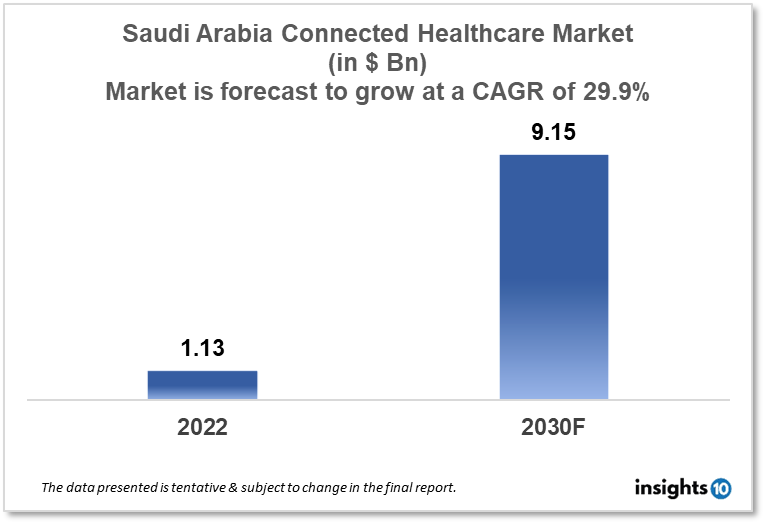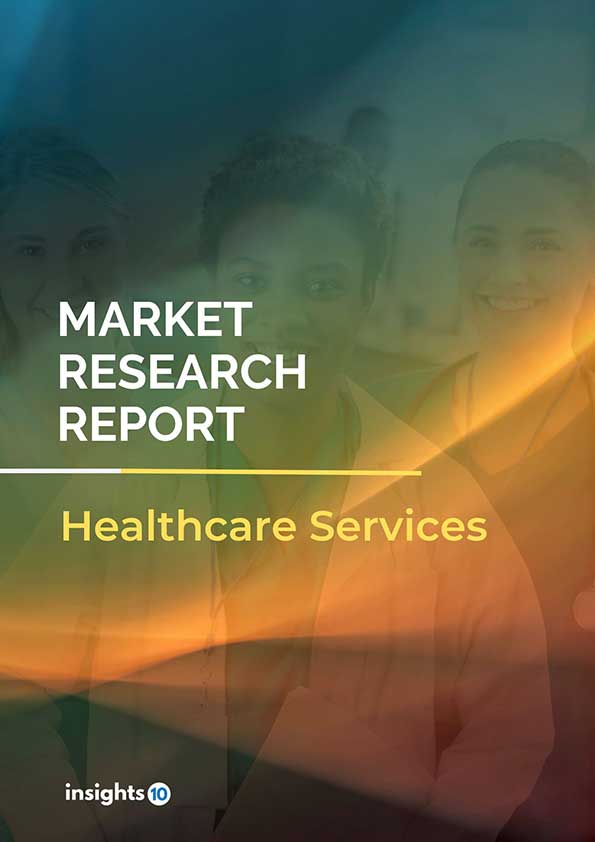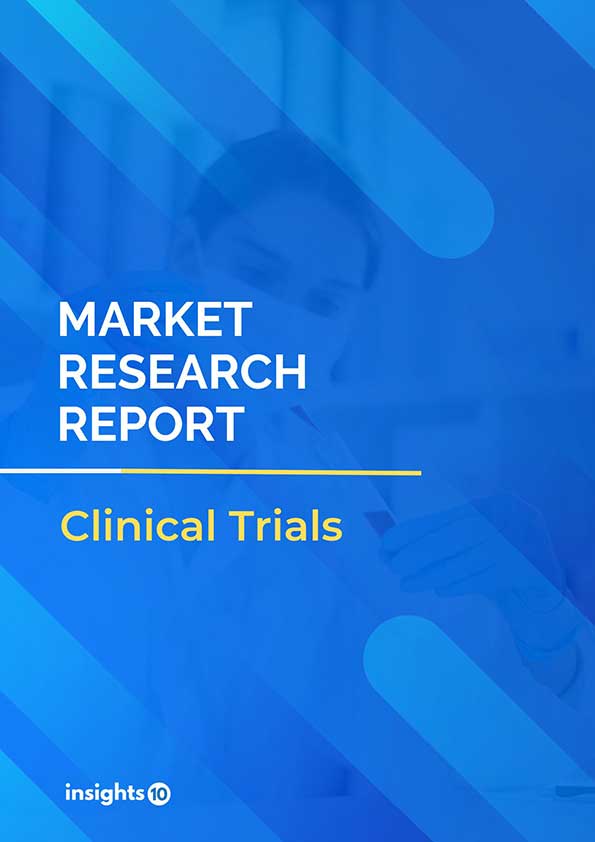Saudi Arabia Connected Healthcare Market Analysis
Saudi Arabia's connected healthcare market is projected to grow from $1.13 Bn in 2022 to $9.15 Bn by 2030, registering a CAGR of 29.9% during the forecast period of 2022-30. The main factors driving the growth would be government support, technological advancements, increasing investment in the sector, and increasing prevalence of chronic diseases. The market is segmented by type, function and application. Some of the major players include Cura, Seha Virtual Hospital, Saudi Telecom Company, GE Healthcare, Honeywell and Apple.
Buy Now

Saudi Arabia Connected Healthcare Market Executive Summary
Saudi Arabia's connected healthcare market is projected to grow from $1.13 Bn in 2022 to $9.15 Bn by 2030, registering a CAGR of 29.9% during the forecast period of 2022-30. In 2019, Saudi Arabia spent 5.69% of its GDP, or $1,316.26, on public health care. There are many opportunities for growth in this high-potential industry, and the Saudi government continues to give healthcare a top priority.
With the government spending extensively on modernizing the healthcare system and enhancing access to healthcare services for its residents, Saudi Arabia is quickly becoming a center for healthcare innovation and technology. The proliferation of connected healthcare solutions in Saudi Arabia is one of the most significant advancements in this area.
Telemedicine service providers, producers of medical equipment, and start-ups in the digital health sector are some of the major stakeholders in Saudi Arabia's connected healthcare business. These businesses are utilizing cutting-edge technology like artificial intelligence, the Internet of Things (IoT), and big data analytics to create novel solutions that can enhance patient outcomes and lower healthcare expenses.

Market Dynamics
Market Growth Drivers
The Saudi Arabia-connected healthcare market is expected to be driven by factors such as:
- Government support- The government of Saudi Arabia has committed significantly to the growth and modernization of the nation's healthcare system, including the promotion of digital health solutions. Its assistance covers programs like the National Transformation Program and the Saudi Vision 2030, which are focused at enhancing healthcare access and quality
- Technological advancements- Innovation in the connected healthcare market is being driven by developments in digital health technologies including artificial intelligence (AI), IoT, and big data analytics. Technological innovations in technology make it possible to create new, better healthcare solutions
- Increasing investment in the sector- Government and private investors in Saudi Arabia are making significant investments in the growth of the connected healthcare market, opening up new business prospects for enterprises in the industry. The market's growth and innovation are being fueled by this investment
- Increasing prevalence of chronic diseases- In Saudi Arabia, chronic conditions like diabetes, cardiovascular disease, and respiratory illnesses are becoming more prevalent, necessitating constant monitoring and management of these conditions. Patients can manage their ailments more successfully and get better results with the aid of connected healthcare technologies
Market Restraints
The following factors are expected to limit the growth of the connected healthcare market in Saudi Arabia:
- Limited digital infrastructure- Despite the government's dedication to advancing digital health solutions, Saudi Arabia still has a limited internet infrastructure, especially in rural areas. For some people, this may restrict their access to connected healthcare services
- Cultural and regulatory barriers- The use of connected healthcare solutions in Saudi Arabia may also be constrained by cultural and legal considerations. For instance, some patients might prefer to meet medical professionals face-to-face rather than through telemedicine, and regulatory restrictions may restrict the application of some digital health technologies
- Limited healthcare workforce- Saudi Arabia suffers from a shortage of medical personnel, which may hinder the uptake and efficacy of connected healthcare solutions. Also, some healthcare professionals could lack the technical expertise needed to use these solutions efficiently
Competitive Landscape
Key Players
- Cura (SAU)- Cura offers telemedicine and remote patient monitoring services. A variety of connected medical devices offered by the company's solutions enable patients to monitor their health at home and communicate the results with healthcare professionals
- Seha Virtual Hospital (SAU)- A healthcare organisation called SEHA runs hospitals and clinics all over Saudi Arabia. The business has created several connected healthcare solutions, such as telemedicine services and tools for remote patient monitoring
- Saudi Telecom Company (SAU)- The connected healthcare sector has been entered by Saudi Telecom Company (STC), a telecommunications firm. The business offers telemedicine services, remote monitoring tools, and digital health platforms as solutions
- GE Healthcare- Saudi Arabia is a key market for the international healthcare firm GE Healthcare. The business offers a variety of connected healthcare solutions, including platforms for healthcare analytics, patient monitoring devices, and medical imaging systems
- Honeywell- A multinational corporation, Honeywell focuses on four business sectors: aerospace, building technologies, performance materials and technology, and safety and productivity solutions
- Apple- Many health and fitness features are available in Apple's Health app and Apple Watch, and the company is working more closely with healthcare organisations to integrate its products into patient care
1. Executive Summary
1.1 Service Overview
1.2 Global Scenario
1.3 Country Overview
1.4 Healthcare Scenario in Country
1.5 Healthcare Services Market in Country
1.6 Recent Developments in the Country
2. Market Size and Forecasting
2.1 Market Size (With Excel and Methodology)
2.2 Market Segmentation (Check all Segments in Segmentation Section)
3. Market Dynamics
3.1 Market Drivers
3.2 Market Restraints
4. Competitive Landscape
4.1 Major Market Share
4.2 Key Company Profile (Check all Companies in the Summary Section)
4.2.1 Company
4.2.1.1 Overview
4.2.1.2 Product Applications and Services
4.2.1.3 Recent Developments
4.2.1.4 Partnerships Ecosystem
4.2.1.5 Financials (Based on Availability)
5. Reimbursement Scenario
5.1 Reimbursement Regulation
5.2 Reimbursement Process for Services
5.3 Reimbursement Process for Treatment
6. Methodology and Scope
Saudi Arabia Connected Healthcare Market Segmentation
By Type (Revenue, USD Billion):
Based on the Type the market is segmented into mHealth services, mHealth Devices, and E- Prescription
- MHealth services
- mHealth Devices
- E- Prescription
By FunctionType (Revenue, USD Billion):
- Remote patient monitoring
- Clinical monitoring
- Telemedicine
- Others (Assisted Living)
By Application Type (Revenue, USD Billion):
- Diagnosis and Treatment
- Monitoring Application
- Wellness and Prevention
- Healthcare management
- Others
Methodology for Database Creation
Our database offers a comprehensive list of healthcare centers, meticulously curated to provide detailed information on a wide range of specialties and services. It includes top-tier hospitals, clinics, and diagnostic facilities across 30 countries and 24 specialties, ensuring users can find the healthcare services they need.
Additionally, we provide a comprehensive list of Key Opinion Leaders (KOLs) based on your requirements. Our curated list captures various crucial aspects of the KOLs, offering more than just general information. Whether you're looking to boost brand awareness, drive engagement, or launch a new product, our extensive list of KOLs ensures you have the right experts by your side. Covering 30 countries and 36 specialties, our database guarantees access to the best KOLs in the healthcare industry, supporting strategic decisions and enhancing your initiatives.
How Do We Get It?
Our database is created and maintained through a combination of secondary and primary research methodologies.
1. Secondary Research
With many years of experience in the healthcare field, we have our own rich proprietary data from various past projects. This historical data serves as the foundation for our database. Our continuous process of gathering data involves:
- Analyzing historical proprietary data collected from multiple projects.
- Regularly updating our existing data sets with new findings and trends.
- Ensuring data consistency and accuracy through rigorous validation processes.
With extensive experience in the field, we have developed a proprietary GenAI-based technology that is uniquely tailored to our organization. This advanced technology enables us to scan a wide array of relevant information sources across the internet. Our data-gathering process includes:
- Searching through academic conferences, published research, citations, and social media platforms
- Collecting and compiling diverse data to build a comprehensive and detailed database
- Continuously updating our database with new information to ensure its relevance and accuracy
2. Primary Research
To complement and validate our secondary data, we engage in primary research through local tie-ups and partnerships. This process involves:
- Collaborating with local healthcare providers, hospitals, and clinics to gather real-time data.
- Conducting surveys, interviews, and field studies to collect fresh data directly from the source.
- Continuously refreshing our database to ensure that the information remains current and reliable.
- Validating secondary data through cross-referencing with primary data to ensure accuracy and relevance.
Combining Secondary and Primary Research
By integrating both secondary and primary research methodologies, we ensure that our database is comprehensive, accurate, and up-to-date. The combined process involves:
- Merging historical data from secondary research with real-time data from primary research.
- Conducting thorough data validation and cleansing to remove inconsistencies and errors.
- Organizing data into a structured format that is easily accessible and usable for various applications.
- Continuously monitoring and updating the database to reflect the latest developments and trends in the healthcare field.
Through this meticulous process, we create a final database tailored to each region and domain within the healthcare industry. This approach ensures that our clients receive reliable and relevant data, empowering them to make informed decisions and drive innovation in their respective fields.
To request a free sample copy of this report, please complete the form below.
We value your inquiry and offer free customization with every report to fulfil your exact research needs.









































